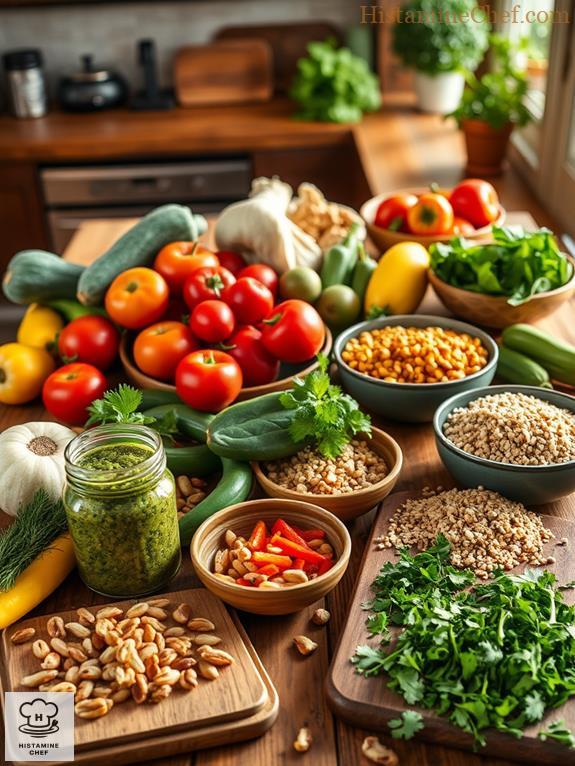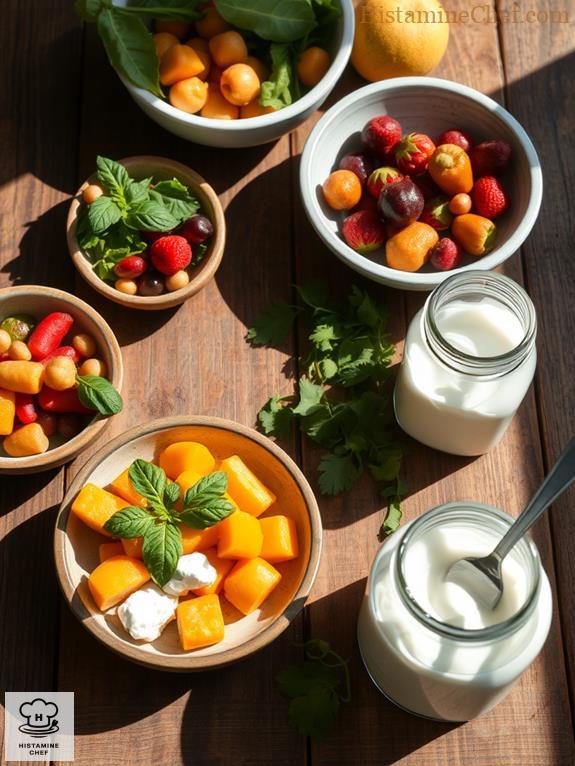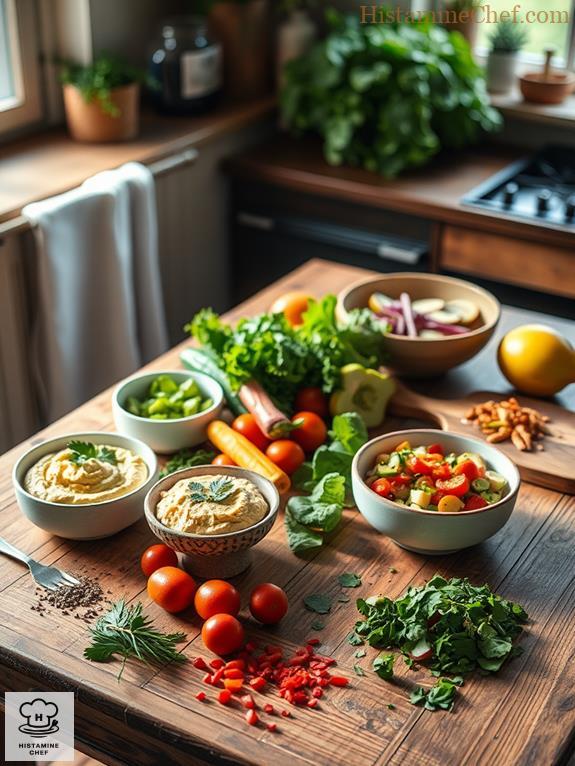Craving fermented foods but histamine-sensitive? I’ve got you covered!
I remember the day my doctor told me to cut out fermented foods. Talk about a culinary crisis! But necessity breeds invention, right?
I started experimenting. Coconut yogurt became my new BFF. Zucchini “sauerkraut”? Surprisingly addictive!
Fresh fruit smoothies? Game-changer for breakfast. And don’t get me started on the magic of lemon juice and fresh herbs.
Trust me, your taste buds won’t even know what they’re missing. Ready to dive into these delicious swaps?
My Histamine-Free Kitchen Disaster: A Lesson in Creativity
So there I was, hosting a dinner party with my new low-histamine diet. Panic set in when I realized my go-to vinaigrette was off-limits.
In a moment of desperation, I blended fresh herbs with lemon juice and olive oil. My guests raved! It was a lightbulb moment.
Sometimes, dietary restrictions can lead to unexpected culinary triumphs. Who knew?
Understanding Low-Histamine Diets

Understanding low-histamine diets can feel overwhelming at first, but it doesn’t have to be.
When I first learned about histamine intolerance, I was confused by all the dietary restrictions. It seemed like a minefield of “no’s.”
But with the SIGHI list as my trusty guide, I discovered a world of allowed foods that were still delicious!
Think of it like a treasure hunt for safe options: fresh fruits like apples and blueberries, or veggies like carrots and zucchini.
Trust me, it’s possible to enjoy meals without feeling deprived.
Fermented Foods Overview

Fermented foods have become increasingly popular, often touted for their potential health benefits. However, for those with histamine intolerance, these foods can lead to uncomfortable reactions.
It’s important to note that fermentation can also be achieved safely with low-histamine ingredients, allowing for some delicious options. But let’s face it, they can cause some serious histamine reactions for many of us.
You know, those tangy delights like sauerkraut and yogurt? They might be great for gut health, but they’re high in histamine, which can be a no-go for folks on a low-histamine diet.
I recall the first time I tried kimchi; I was excited until my stomach wasn’t!
If you’re cautious about what you eat, it’s essential to focus on safe options. Keep in mind to check the SIGHI list for guidance on which foods are allowed and which to avoid.
Safe fermentation tips can help you navigate this tricky landscape.
Stay tuned as we explore some delicious low-histamine alternatives in this blog, Histamine Chef!
Low-Histamine Alternatives

When it comes to finding low-histamine alternatives to traditional fermented foods, I’ve discovered some fantastic options that won’t trigger those pesky reactions.
Additionally, you can explore various delicious dairy-free cheese alternatives that fit within a low-histamine diet.
Here are three of my favorites:
- Coconut yogurt – Creamy and delicious, it’s a great swap for dairy yogurt!
- Homemade sauerkraut with allowed ingredients – Just use low-histamine veggies, and it’s a simple cooking technique.
- Fresh fruit smoothies – Blend allowed fruits like blueberries and nectarines for a revitalizing treat!
These ingredient swaps let you enjoy flavor without the histamine headache.
Cooking Tips for Substitutions

I often find that experimenting with substitutions in cooking can lead to delightful discoveries, especially when it comes to maintaining a low-histamine diet.
For instance, using smart substitutions can make a significant difference in flavor and texture while keeping your meals histamine-friendly. Have you ever tried swapping out traditional dairy with almond or coconut milk? It’s a game-changer!
When meal prepping, consider using quinoa instead of restricted grains for a great texture variation.
For seasoning options, fresh herbs can elevate flavors without the histamine risk. Don’t forget about nutrient balance; incorporating a variety of allowed vegetables can keep meals exciting and safe.
Recipe modifications can be fun! Just keep in mind to stick to low-histamine ingredients from the SIGHI list.
Incorporating Alternatives Into Meals

Here are three fun ways to incorporate alternatives into your dishes for meal enhancement and flavor balancing:
Experimenting with substitutions in cooking opens up a world of possibilities for creating delicious, low-histamine meals.
For instance, using vinegar alternatives can elevate flavors without the histamine load.
- Use coconut milk instead of yogurt in smoothies for a creamy texture without the histamine headache.
- Swap out vinegar for lemon juice to brighten salads without triggering sensitivities.
- Try fresh herbs instead of dried ones, as they pack a punch of flavor without the risk.
FAQ
Can I Eat Fermented Foods if I Have Low Histamine Levels?
I can’t eat fermented foods because they often trigger histamine reactions. I focus on safe alternatives that don’t cause discomfort, ensuring my meals are enjoyable without risking my health. Staying informed is key for me.
What Are the Symptoms of a Histamine Intolerance?
When I first noticed my body reacting like a car misfiring, I realized histamine intolerance was at play. Common triggers included certain foods, leading to digestive issues, headaches, and skin reactions I couldn’t ignore.
How Do I Test for Histamine Intolerance?
To test for histamine intolerance, I recommend consulting a healthcare professional. They can guide you through histamine testing and help with an intolerance diagnosis, ensuring your safety and well-being throughout the process.
Are There Any Supplements to Help With Histamine Intolerance?
I’ve found that probiotic supplements and digestive enzymes can be helpful for managing histamine intolerance. They may support gut health, but I always recommend consulting with a healthcare professional before starting any new supplements.
How Long Does It Take to See Results From a Low-Histamine Diet?
When I started on my low-histamine diet journey, I noticed symptom relief within a few weeks. Typically, people see results around 4-6 weeks, but diet duration varies based on individual sensitivities and commitment.
Summary
I’ve discovered exciting low-histamine alternatives to fermented foods, expanding my culinary horizons. These options keep my symptoms at bay while offering diverse flavors and textures. I continue to explore new recipes, finding creative ways to enjoy meals without histamine concerns.
What’s your experience with low-histamine alternatives? Have you found any surprising substitutes for fermented foods? Share your thoughts in the comments below.
Help spread the word about low-histamine eating by sharing this post on your social media. Your support helps grow the Histamine Chef community and reach others seeking histamine-friendly recipes.


Leave a Reply